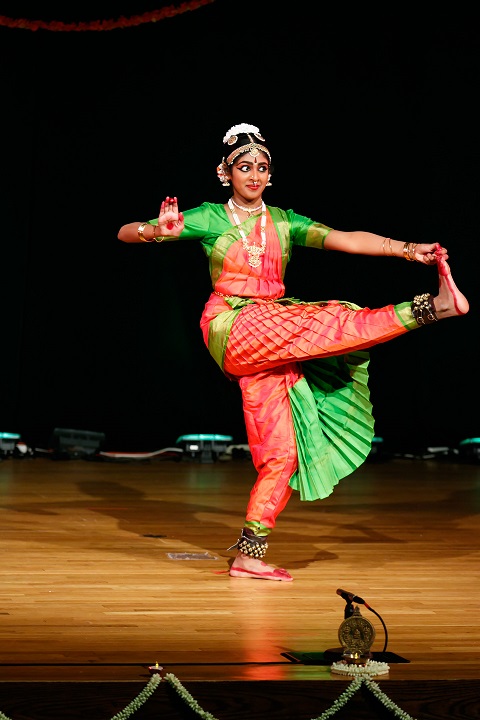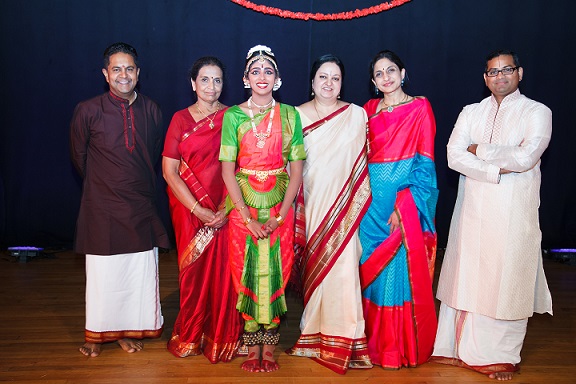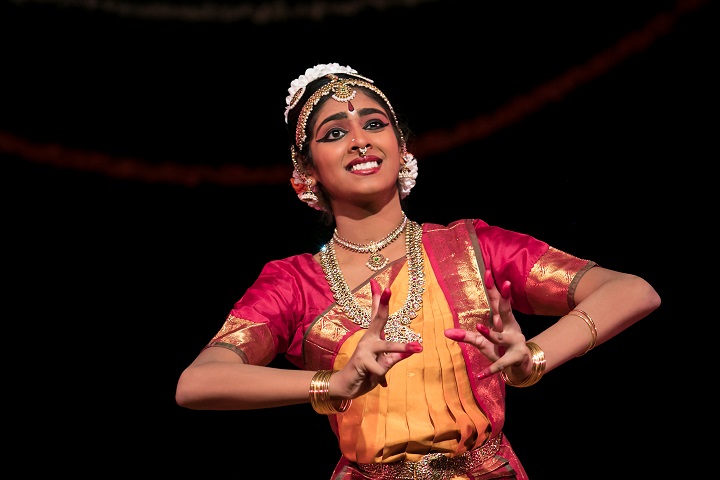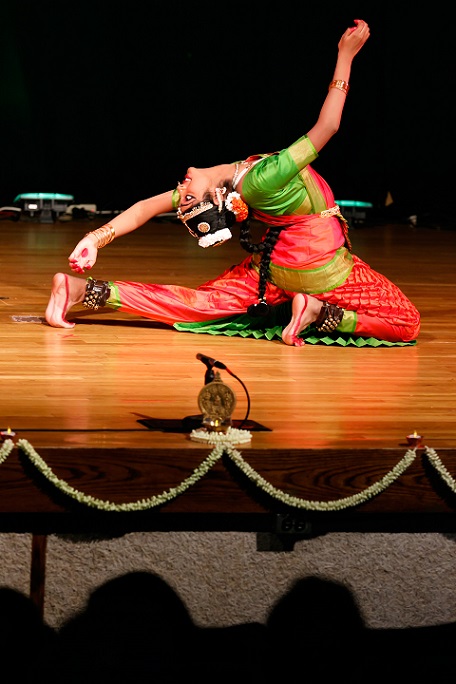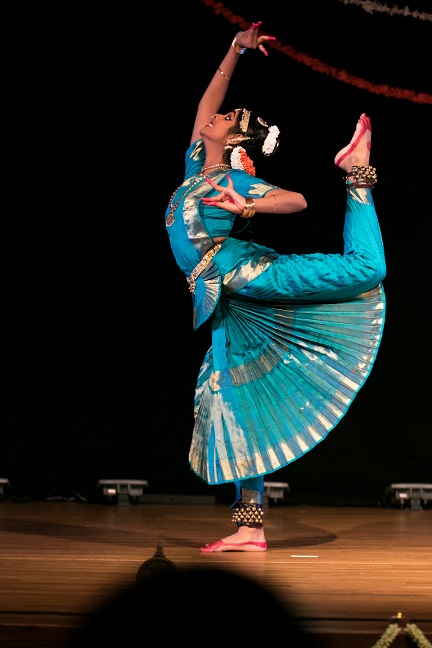Smita Rajan, presented her Bharatanatyam Arangetram (ascending of the stage) at the Maliotis Cultural Center in Brookline MA on June 19th, 2016. Smita is a student of Guru Smt. Sunanda Narayanan, an acclaimed exponent of the Vazhuvoor style of Bharatanatyam and director of the Thillai Fine Arts Academy in Newton, MA. Smita had the privilege of having her teacher's Guru Smt. Rhadha as a guest of honor in the audience.
From the opening notes of the Thodaya Mangalam till the fading sounds of the final Mangalam, Smita delivered the margam with immense charm, stamina, and most importantly, joy. The margam opened with the traditional Alarippu where Smita illustrated her mastery of adavus, the foundation of Bharatanatyam. Guru Sunanda’s crisp sollukattu in concert with the melodious vocals of Mr. Srirangam Prasanna Venkatesh coalesced into a dramatic rendition, culminating most appropriately with a Sanskrit prayer invoking Lord Ganesha’s blessings in a sloka called Mooshika Vahana.
Smita next tackled a traditional Jatiswaram, a very taxing piece in which endurance and stamina is key. Clusters of complex adavus were punctuated by challenging poses that demonstrated Smita’s remarkable flexibility. Smita impressed the audience with her grasp of complex rhythmic patterns and her crisp hand and foot movements (Nritta). This piece was notably made famous by Guru Rhadha.
Kanja Dalayatakshi, a piece in praise of the Mother Goddess introduced the audience to Smita’s abinaya. At moments, one felt as though the Mother Goddess was shining through this young dancer as she demonstrated the gentle benevolence of the Mother Goddess, her sashaying gait, her sweet smile and her aspect as Mother of the Universe.
In place of the traditional varnam, Smita presented a “Saptharatna Krithi†of Oothukadu Venkatasubbaier, Balasarasa Murali, in the Ragam Keeravani where Lord Krishna’s love and compassion to all humanity was depicted. Guru Sunanda’s choreography was particularly suited for this young dancer. The jatis were vigorous and complex with fast paced movements. The interludes of abinaya showcased numerous stories from Lord Krishna’s life. In one particular interlude, Smita beautifully conveyed all of nature enraptured by the sounds emanating from Krishna’s flute, drawing the audience into his intoxicating music, lulled by the dulcet sounds of Smt. Tara Anand’s violin and Smt. Durga Krishnan’s veena. The chittaswaram portion was nonstop action with inspired choreography by Guru Sunanda that kept the audience on the edge of their seats. A garland of fast paced stories was presented which was a test of the Smita’s endurance and training. Here the incredible collaboration by Guru Sunanda and her shishya was in evidence.
Guru Sunanda’s ability to extract the best out of each of her students and present a polished and professional performance is the hallmark of her teaching style. Smita continued this tradition in full force. The fast paced chittaswarm gave way to the heart of the piece, three pivotal points in Krishna’s life, as a kind young boy, a loyal and dear friend to Sudama and finally the highly charged and emotional Draupadi vastraharanam. Smita did full justice to all elements of this piece and the 30 minutes went by in a moment, leaving the audience, like Krishna’s gopis yearning for more. Much can be said about the incredible orchestra. Mr. Srirangam Prasanna Venkatesh made his debut to the Boston audience and his voice reverberated around the auditorium with passion and reverence. The inspired choice of using “thanam†in the “Govardhana Giridhara†episode was particularly powerful. Smt. Tara Anand and Smt. Durga Krishna, stalwarts of the New England Carnatic music scene have performed countless arangetrams together. The audience at Smita’s arangetram was witnesses to this wonderful musical partnership with violin and veena playing together and then chasing each other in the lively chittaswaram portions.
The post-intermission portion of the margam commenced with the melodious Idathu Padham, in Ragam Khamas in praise of Nataraja, Lord of the Chidambaram Temple also known as Thillai. This piece showcased Smita’s strength in holding difficult statuesque poses with such ease. This was followed by Muruga Muruga, a deeply devotional piece in praise of the beloved South Indian God Muruga. The composer was none other than the famous Tamil poet Subramanya Bharati who’s poetry beautifully brought to life the swaying movements of Lord Muruga’s vahana, the peacock, which was then followed by Smita’s sincere portrayal of the tribulations Muruga’s followers willingly put their bodies through to show their bhakthi to their beloved God.
Smita’s next piece was Naadhar Mudi a piece made famous by Kumari Kamala (Smt. Rhadha’s sister) where the dancer addresses the divine serpent “Dance and sway in joy O snake and do not dart angrily at meâ€. This piece highlighted the incredible flexibility of this dancer. Smita swayed and weaved in a mesmerizing manner, her arms, hands, fingers, indeed her whole body seemed to embody the King Cobra as she sinuously traversed the stage to the hypnotic music of the incredibly talented orchestra. Sri Murali Balachandran a veteran mridangam exponent, in addition to the scintillating percussive beats of this mridangam, introduced the Kanjira drum, which added a unique ambiance to this piece. What a treat for Smita to perform this piece in front of Smt. Rhadha who was able to witness yet another interpretation of this unique composition.
The performance culminated in an electric performance of Sri Lalgudi Jayaraman's Thillana in Ragam Durga. Once again, Smita’s stamina held her in good stead as this demanding Thillana in praise of Goddess Durga was fast paced and intricate and interspersed with poses depicting Durga as Mahisharsura Mardini, the destroyer of the evil asura Mahisha. Till the final strains of the benediction to Lord Rama in the Mangalam, Smita showed poise and comfort with the stage that belied her youth.
This whole performance illustrates the importance of the Guru in the dance tradition. Guru Sunanda’s dedication to the art form shines through in each of her students. The dancers she puts forth are drilled in the classical tradition, in this case the Vazhavoor style of Bharatanatyam in which subtle abinayam, graceful movements, statuesque poses and demanding pure dance sequences are emphasized. This brought to mind a quote about the Vazhavoor style of Bharatanatyam from a leading exponent of Bharatanatyam, Lakshmi Viswanathan about Ramiah Pillai, Guru Rhadha’s teacher and the doyen of this style, "The nritta aspect of Bharata Natyam shone in vibrant vitality throughout Ramiah Pillai's teaching career. He gave equal importance to Abinaya; but his style demanded a certain lilt which was at once dynamic and graceful. He was the first one to introduce sticking poses in Bharata Natyam. This sculpturesque quality became his hallmark and to this he added facile movements to make his dancers look like elegant ballerinas," Guru Sunanda faithful adherence to the principles of this style is unerring. Interestingly, Smita trained in ballet and was thus an ideal candidate to inherit the mantle of the Vazhuvoor bani and was fully deserving of the standing ovation she received at the completion of the margam.
